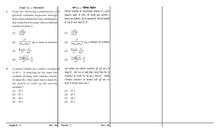Joint Entrance Examination
Joint Entrance Examination (JEE) is an all India common engineering entrance examination which is conducted for admission in various engineering colleges and courses all over the country.
In 2012, CBSE (Central Board of Secondary Education) has announced this common examination in place of AIEEE and IIT-JEE. JEE is being conducted in two parts, JEE-Main and JEE-Advanced. JEE-Advanced is for admission in Indian Institutes of Technology (IITs), and Indian School of Mines Dhanbad (now getting converted into IIT)[1] and JEE-Main exam is for admission in IIITs (Indian Institutes of Information Technology), NITs (National Institutes of Technology), CFTIs (Central Funded Technical Institute) and IIEST Shibpur, for admission to its dual degree programme.[2]
As IIT's are the premier engineering colleges in India, only top 1,50,000 candidates in JEE-Mains are eligible to appear for JEE-Advanced exam. The candidates who clear JEE-Advanced exam have the opportunity to join either of the IIT's. The candidates who clear JEE-Mains but are not eligible for JEE-Advanced or do not get clear JEE-Advanced can seek admission in other engineering colleges such as Indian Institute of Information Technology, National Institute of Technology, and other government and private engineering colleges.
There are some colleges like IISER's, RGIPT, IIsc and others which use score of JEE Advanced for admission. These are not participating institutes of Central IIT JEE Advanced counselling of which all IITs are a member. Any student who takes admission in IIT's cannot appear for JEE-Advanced exam next year, but the same is not the case with IISER, RGIPT and other institutes as these institutes only use JEE Advanced score and they have no connection with IIT central counselling.
In September 2013, the IIT Council approved the decision of the Joint Admission Board to continue with the two-phase JEE pattern ("Main" followed by "Advanced") for IITs in 2014.
The JEE-Mains for 2015 was held on April 4, 2015. Currently, a major controversy is raging on the various inconsistencies in the answer keys published by CBSE as pointed out by several students and coaching institutes which put a question mark over CBSE's ability to host this examination. The result was announced on 27 April 2015 .[3]
Pattern of examination

JEE Main
JEE-Main Exam has two papers, Paper-1 and Paper-2. Candidates may opt for either or both of them. Both papers contain multiple choice questions.
- Paper-1 is for admission in B.E./B.Tech (online and offline).
- Paper-2 is for admission in B.Arch and B.Planning (offline only).
- 1.3 Million students including 316,000 female candidates appeared for JEE-Main exam in 2014.[4]
JEE Advanced
Students who qualify JEE-Mains can appear for JEE-Advanced examination. Approximately 150,000 students qualify to appear for JEE-Advanced examination.[5] The All India Ranks (AIRs) for JEE Main 2014 have been declared.[6] Students who obtain All India Ranks (AIRs) and wish to study Architecture or Design need to appear for an Architecture Aptitude Test (AAT) and qualify.
- 1.19 lakh students appeared for JEE Advanced in 2014 out of which 27,152 qualified of which 14,269 i.e. 52.55% qualified from 11 Indian cities.[7]
History
The JEE pattern has undergone many changes. Since 2010, the candidates are given paper copies of their answers, and cutoffs are announced.[8] This transparency was achieved after a tenacious legal tussle waged by IIT Kharagpur professor Rajeev Kumar,[9] who won the National RTI Award 2010 for his crusade.[10]
JEE main counselling
CBSE and CSAB are two different and independent boards. CBSE conducts JEE (Main) examination and publishes the merit list. CSAB only uses the merit list published by CBSE for seat allocation purposes. In previous years the admission process was conducted through CCB (Central Counseling Board), while this year CCB has been renamed as CSAB (Central Seat Allocation Board) for completing the seat allocation process.
See also
- Graduate Aptitude Test in Engineering (GATE)
- SAT Reasoning Test
- ACT (test)
References
- ↑ ISM Dhanbad to be converted into IIT
- ↑ New Admission format of JEE for admissions to engineering colleges. India Today. Retrieved on: 2014-08-22.
- ↑ http://cbseresults.nic.in/jee/jee_2015.htm
- ↑ http://indiatoday.intoday.in/education/story/jee-mains-2014-14-lakh-candidates-appeared-for-the-exam/1/353322.html<
- ↑ http://indiatoday.intoday.in/education/story/jee-mains-2014-online-exam-begins-today/1/353681.html<
- ↑ http://www.shiksha.com/news/jee-main-2014-all-india-ranks-declared-article-8735-1
- ↑ http://indianexpress.com/article/india/india-others/jaipur-sends-highest-number-of-students-to-iits-delhi-is-second/
- ↑ Vinita Deshmukh (1 November 2012). "Irregularities in IIT JEE: Will the new HRD minister offer justice to this tenacious whistleblower?".
- ↑ Charu Sudan Kasturi (April 30, 2013). "For "unsung hero" behind IIT JEE transparency, some reprieve after years of torment". Hindustan Times. quote= Kumar, dubbed by the Supreme Court of India as an “unsung hero” responsible for much of the transparency introduced in the IIT entrance examination in recent years
- ↑ http://www.rtiawards.org/prof_rajeevkumar.html
External links
| ||||||||||||||||||